6 DIY Bunk Beds With Stairs You Can Construct Today (With Pictures)
-
Pete Ortiz
- Last updated:

Housing a huge family can be incredibly expensive. Chances are that your children each want their own room or are unwilling to share a bed. Luckily, bunk beds exist for that reason.
Kids also love them, or at least the bunk beds with unique designs. There are many bunk bed ideas, and some are easy to make. However, making bunk beds often requires woodwork skills; you don’t want the upper bed to break and hurt the person sleeping on the bottom bunk.
In this article, we’ll list some of the bunk bed ideas you can make with some basic building skills and inexpensive materials. Almost every kid loves sleeping in a bunk bed, even when it’s not practical. Check out the following plans to determine which one works best for you.
The 6 DIY Bunk Beds With Stairs
1. DIY Cabin Loft Bunk Bed by Ana White
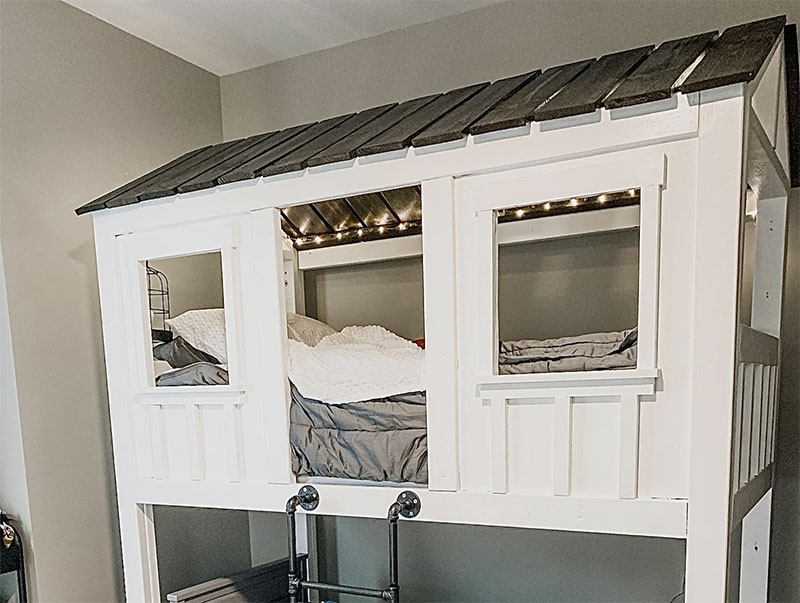
| Materials: | Screws, ladder, wood panels, guardrails, lights, curtains |
| Tools: | Screwdriver, tape measure, wood saw, nail gun |
| Difficulty Level: | High |
Cabin loft bunk beds are popular because of their unique design. This also means that you are unlikely to find many people with a similar bunk bed. Covering the top bed with a mini-cabin loft offers the person sleeping in that bed extra privacy and turns their sleeping experience into a mini-adventure. It also gives the room a more distinct look.
To make a cabin loft bunk bed, you need an experienced builder to help you draw up the plans. Please note that building the loft design on the upper bunk is similar to building a tiny loft. Ensure you use top-quality wood and increase all the dimensions by around 3 inches to make the mattress fit in more easily.
Build the upper bunk bed first and then add the loft design—ensure you’ve left ample space at the bottom for the lower bed to fit. You can also add a smaller single bed under the upper bunk if it’s for a small kid.
Consider adding lights on the upper bunk to prevent it from getting too dark, especially if you add a door or curtains.
2. DIY Triple Bunk Beds by Jen Woodhouse
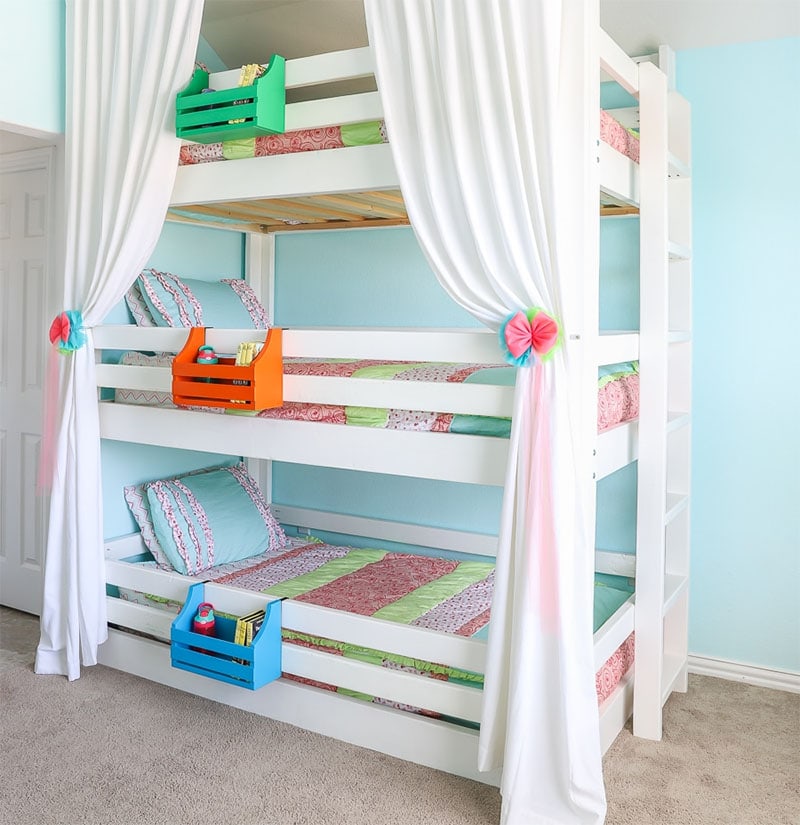
| Materials: | Screws, ladder, wood panels, guardrails |
| Tools: | Screwdriver, tape measure, wood saw, nail gun |
| Difficulty Level: | Moderate |
If you have three kids and want them to share one bedroom, you can build them a triple bunk bed. There are two ways to do this. You can add two beds at the bottom and a large bed at the top; this design will look more like a double-decker bed. However, building a triple bed with three beds at different levels offers the kids more privacy.
Consider placing the first bed on ground level to save space when building a triple bunk bed. The second upper bed and the top bed should both have guardrails. The ladder should also go from the top bunk to the bottom bunk.
3. DIY L-Shaped Bunk Beds by Maxtrix Kids
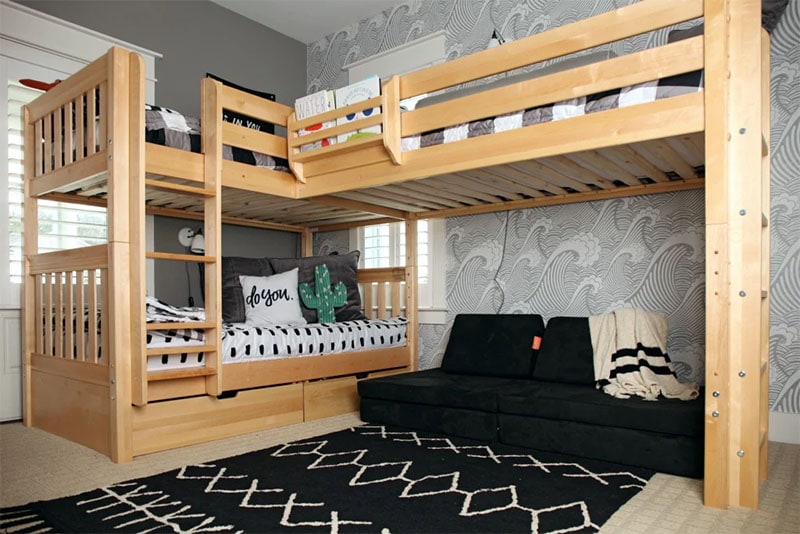
| Materials: | Screws, ladder, wood panels, guardrails |
| Tools: | Screwdriver, tape measure, wood saw, nail gun |
| Difficulty Level: | High |
L-shaped bunk beds enable you to have more space in your room. They are safe and appropriate for all ages, and you can have four beds or desks below the two upper bunk beds for the kids to do their homework. These beds also give you extra space for guests.
Since L-shaped bunk beds have a challenging design, they require you to have advanced woodworking skills. If not, you should hire a professional. This is because building this bunk bed requires you to align many joints and know the right ladder positioning.
4. DIY Built-in Bunk Bed by Angela Rose Home

| Materials: | Ladder, wood panels, guardrails, concrete |
| Tools: | Tape measure, wood saw, nail gun |
| Difficulty Level: | Moderate |
Built-in bunk beds are only applicable if you own the house. If you don’t, you risk being sued by the landlord and not getting your deposit back when you move. Apart from that, they are pretty appropriate, especially when you’re sure your family will live in that house for a long time. If the bunk bed is for kids, you can paint exciting colors and patterns on it.
When building a built-in bunk bed, the dimensions need to be pretty accurate because you will not be able to move it after you’re done. Make the wooden trimmings and nail them into place. After that, you can add concrete between the spaces and smooth it out. Add the ladder and guardrails to the bunk bed; they should be wooden or metallic so you can change them as the kids grow.
You can also add a slide on the other side of the upper back to make coming down an exciting experience for the kids, especially if they use their room as a play area during winter.
5. DIY Murphy Bunk Beds by Ideas2Live4
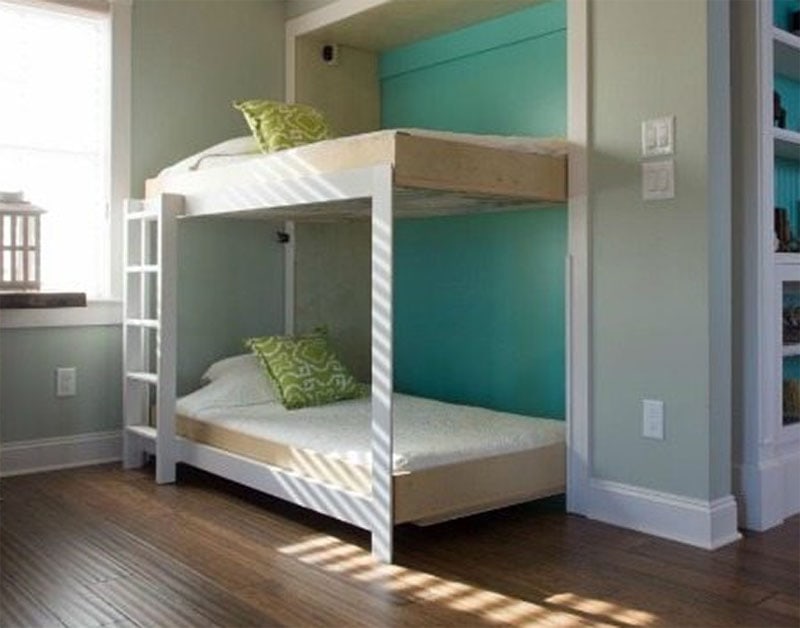
| Materials: | Screws, ladder, wood panels, guardrails, springs, hinges, wood shims, wood glue, 3/4″ birch edge banding, trim paint, two-part epoxy, 100 15-ga. 11/4″ finish nails, bolts |
| Tools: | Screwdriver, tape measure, wood saw, nail gun |
| Difficulty Level: | High |
If you have a spare room that you want to use as a guest room while still using it in another capacity, Murphy bunk beds will come in handy. You can retract it when guests come over and put it back when it’s not in use. It also saves space by making space above the first bed.
You need strong hinges when building one since the bed will be floating. Ensure you screw the bolts in tightly while still ensuring that they can open and close without squeaking. The ladder should be detachable so the beds can fit in their storage space.
Since it’s quite easy for these beds to malfunction if not built properly, you may want to hire a professional to guide you and help you do it right. You can also use decorated wood or paint the bottom of the beds to make it more aesthetically pleasing when the bunk bed is pushed back into the wall.
6. DIY Camper Bunk Beds by Sportsmobile

| Materials: | Ladder, wood panels, guardrails, concrete, hinges, straps, birch edge banding, bolts |
| Tools: | Tape measure, wood saw, nail gun |
| Difficulty Level: | Moderate |
Whether you live in your RV or only use it while traveling, having a bunk bed makes sleeping arrangements easier. The size of the bunk beds depends on the dimensions of the camper, so bunk beds can have bigger dimensions. You can even fold up the camper beds when they are not in use.
Adding netted pockets to the bottoms of the camper bunk beds creates convenient storage space for books, magazines, and bedding. The upper bunk can be a permanent fixture since it can be used as a shelf. However, ensure that you secure the cargo when traveling.
What to Consider When Building a Bunk Bed
Bunk beds can be dangerous, and many children, including teens, injure themselves each year, either getting on the upper bed or getting down. They need to be safe and stronger than a single bed, especially if the person sleeping on the upper bunk is an adult.
There are several things you need to consider. They include:
1. Guardrails
Guardrails prevent the persons sleeping on the upper deck from rolling out of bed at night. They are mandatory, even for the side against the wall. The guardrail opposite the wall should run from one end of the bed to the other with no gaps, no matter how small. They should also be fixed firmly in place to prevent children from removing them.
2. Ladder
If the upper bed is more than a meter high from the ground, it needs to have a ladder. It makes going up and coming down easier and prevents injury caused by falling. The gaps between the steps should be less than 12 inches. They should also be very stable and sturdy.
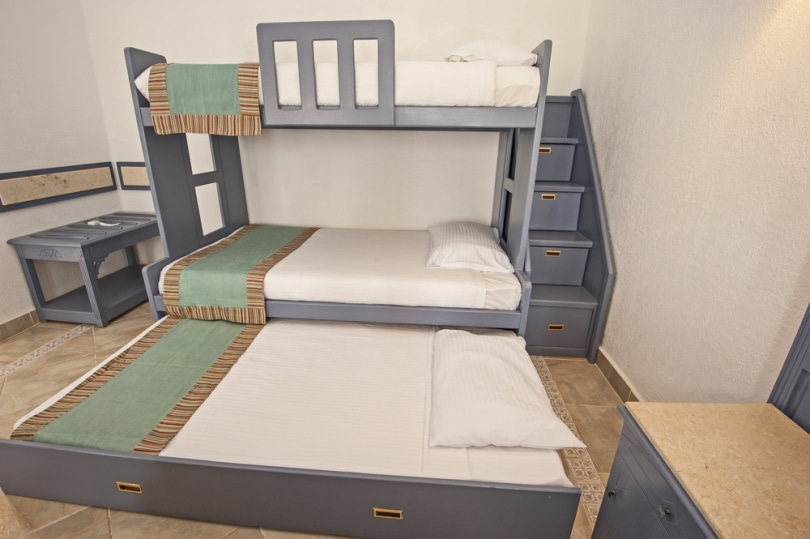
3. Ends
All bunk beds need to have a headboard and footboard. They keep the bed neater for longer. Having them can also prevent kids from falling out. To make the ends look more authentic, curve them or add unique patterns.
Conclusion
Bunk beds are amazing due to their versatility. They are also appropriate for all ages, although the youngest child should ideally use the bottom bunk.
Please note that if the top bunk is not assembled correctly, it can collapse and injure the child in the lower bunk. Therefore, ensure you have the right skills before embarking on building one. If you cannot build one, you can buy the parts from Ikea and assemble them at home.
Featured Image Credit: cfesd, Pixabay
Contents



